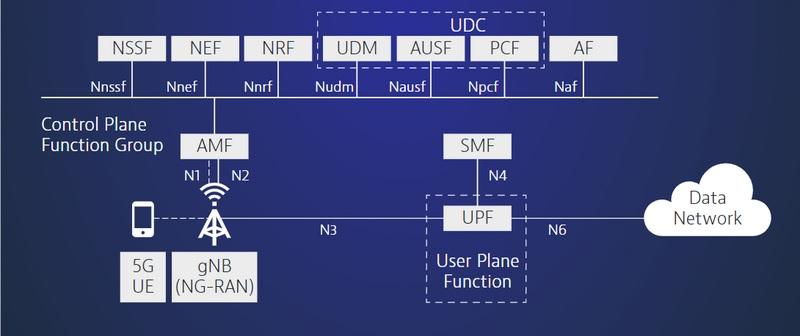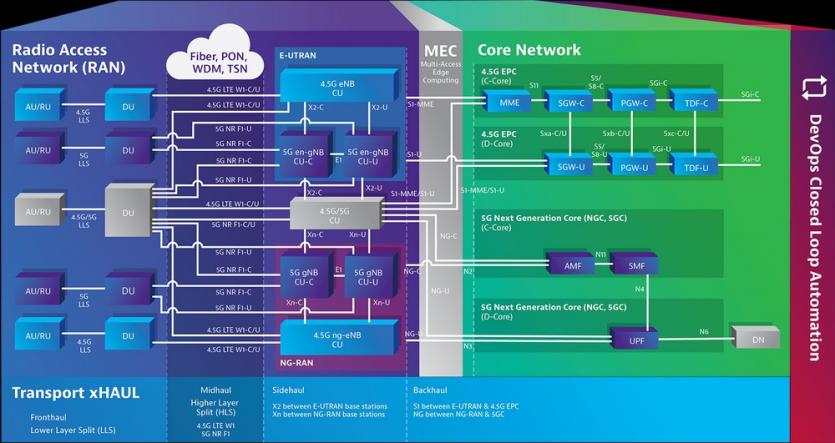How The 3GPP Collaborative Project Describes The 5G Architecture
The Original Goal Of Previous Generations Of Mobile Networks Was To Provide Practical And Reliable Services To Users. With The Expansion Of This Domain, 5G Technology Intends To Offer A Wider Range Of Wireless Services To The End User Through Multiple Access Platforms And Multilayer Networks.
3GPP, the 5G network, is a dynamic, cohesive, and flexible framework of several advanced technologies that support various applications. 5G uses a more innovative architecture in which Radio Access Network (RAN) networks are no longer limited by proximity to a base station or complex infrastructure. The 5G directs the signal transmission path through a separate, flexible, virtual RAN with new interfaces that provide additional data access points.
5G 3GPP architecture
The 3GPP collaborative project focuses on telecommunications technologies such as RANs, core transportation networks, and service capabilities. 3GPP provides complete specifications for 5G network architecture, which is more service-oriented than previous generations.
Services are provided through a common framework to key network components authorized to use these services. Modularity, reusability, and self-control of network operations are additional and essential requirements addressed when designing and implementing 5G networks, and 3GPP emphasizes them.
5G spectrum and frequency
Currently, different frequency bands are available in the New Radio interface (NR) called New Radio, which 5G can use and is open to operators. Part of this radio spectrum with frequencies between 30 and 300 GHz is known as millimeter wave because its wavelengths are between 1-10 millimeters. Currently, frequencies between 24 and 100 GHz are reserved for 5G networks in several countries.
In addition to the millimeter-wave, the low-power UHF frequencies, between 300 MHz and 3 GHz, can change functionally so that 5G networks can use them because higher frequencies are characterized by greater bandwidth and, of course, shorter range, the variety of frequencies used can adjust for unique applications. Millimeter-wave frequencies are ideal for densely populated areas but are useless and ineffective for telecommunications.
Multi-access edge calculations

MEC Multi-Access Edge Computing is an essential component in the 5G architecture. MEC is a breakthrough in cloud computing that brings applications from centralized data centers to the edge of the network and thus closer to end-users and their devices. The MEC is a bridge between the user and the host for content delivery.
This technology is not limited to 5G, but it certainly plays a vital role in its performance. MEC features include low latency, high bandwidth, and instant access to RAN data, which sets the 5G architecture apart from previous generations. This convergence of RANs and core networks requires operators to take new network testing and validation approaches.
5G networks based on 3GPP 5G specifications provide an ideal environment for MEC deployment. Key 5G components define powerful capabilities for edge computing, allowing the MEC and 5G to drive traffic together. In addition to its ability to reduce latency and increase bandwidth, the MEC architecture enables the distribution of computing power, the ability to connect a large number of devices to the 5G network, and the support and management of a wide range of IoT sensors.
Virtualization of network and 5G performance
Network Function Virtualization (NFV) Network Function Virtualization separates software from hardware by replacing various network functions such as firewalls, load balancers, and routers with virtualized instances that run as software. It eliminates the need to invest in more expensive hardware equipment and can reduce installation time. An approach that makes revenue generation faster than customer service.
NFV enables 5G infrastructure by virtualizing equipment within the 5G network, including network slicing technology that allows multiple virtual networks to run simultaneously. NFV can meet other 5G challenges through computing, storage, and virtualized resources based on applications and customer grouping.
5G RAN architecture
Network performance virtualization can extend to RANs through network segregation and the use of technologies recommended by unions such as O-RAN. The above approach increases flexibility and allows operators to deploy 5G sites quickly. It provides a design and development mechanism based on open platforms and interfaces that facilitate the deployment of new features and technology. The purpose of the union
O-RAN ALLIANCE is to simplify setting up networks whose equipment is supplied by various hardware vendors. Typically, 5G networks use the hardware requirements of a single manufacturer, but sometimes the situation requires the use of products from different vendors; In such cases, it should ensure that the interaction of the equipment with each other is easier and faster.
In addition, network segregation enables the virtualization of network components and provides a way to expand and improve the user experience by increasing capacity. The benefits of RAN component virtualization are a more cost-effective solution than purchasing the specific hardware needed to implement IoT services.
eCPRI
Network segregation and the division of functions have many economic benefits, especially with introducing new relationships such as eCPRI. Tests performed by 5G operators show that RF connections are no longer cost-effective because RF costs are rising rapidly; That’s why eCPRI interfaces were invented as a more cost-effective solution because they use fewer interfaces. ECPI aims to provide a standard interface for 5G. For example, the front haul O-RAN interface uses a Distributed Unit. CPRI, unlike eCPRI, was developed for 4G and was designed more to help hardware vendors.
Network segmentation
Perhaps network segmentation is the key element that allows the 5G architecture to be implemented in the best and most complete way. The technology on which most 5G networks are implemented today has become one of the main pillars of 5G networks because it allows end-to-end virtual networks that provide networking and storage capabilities.
This technology adds an extra dimension to the NFV domain by preparing the possibility of running multiple logical networks simultaneously on top of a shared physical network infrastructure. Operators can better manage key parameters of 5G networks by dividing network resources between multiple users or tenants, such as throughput and delay.
The above approach makes it more efficient to respond to different requests for access to the network. Network segmentation is helpful for applications such as IoT, where the number of users may be high, but the overall bandwidth demand is low. Each 5G network architecture has its requirements, so network segmentation has become an essential model in designing 5G network architecture.
Costs, resource management, and network configuration flexibility can optimize with this level of customization. In addition, faster test network segmentation makes the new 5G application service easier and makes it possible to estimate customer service delivery time.
figure 1
Beamforming
Another important and valuable technology for the success of 5G is beam shaping. Conventional base stations send signals in multiple directions, regardless of the location of the target users or devices.
Using multi-input, multi-output (MIMO) arrays that include dozens of small antennas combined into a single shape, signal processing algorithms can determine each user’s most efficient transmission path while separating separate packets. It can be sent in several directions and then lined up in a predetermined sequence to reach the end-user (Figure 2).
Because when transferring 5G data packetsMillimeter bandwidth is rapidly gaining ground. We encounter various problems, the most important of which are outdoor transmission losses, disproportionate transmission and reception due to smaller antennas, diffraction losses, and lack of penetration into the wall.
However, smaller antennas make it possible to place larger arrays in a physical space. Because each of these smaller antennas potentially changes the direction of the beam several times per millisecond, they make it possible to form large beams to overcome the challenges of 5G bandwidth. With the higher density of antennas in the same physical space, narrower beams can be achieved using MIMO technology, thus providing a solution to achieve high throughput with more effective user tracking.
5G central architecture
The 5G core network architecture is at the heart of the 5G specs, making it possible to increase the demand for 5G throughput. 5G Central Architecture, as defined by 3GPP, uses a cloud-based service (SBA) architecture that covers all 5G functions and interactions, including authentication, security, session management, and end-device traffic aggregation.
The core network focuses more on NFV as a design component integrated with virtualized software functions, which can be deployed using the MEC infrastructure, the most crucial element in the principles of 5G architecture. Figure 2 shows this architecture.

figure 2
5G and 4G architectural differences
The changes in the underlying layers are pervasive, and these differences make 5Goffer higher throughput than 4G. These changes include using the millimeter-wave, the Massive MIMO, the network segmentation, and the key components that form the basis of the 5G ecosystem—for example, the member.
The Evolved Packet Core used in 4G has an entirely different function to 5G, allowing 5G networks to best support the virtualization and design of native cloud software.
Other changes that differentiate 5G networks from the previous generation, UPF is the name of the user plane function, which is used to separate Packet Gateway Control, User Plane Functions, and AMF access and mobility management function of the name Mobility Management Function. It is possible to separate meeting management functions from management activities related to connectivity and mobility.
5G architecture options
One of the essential points that some operators use to fill the gap between 4G and 5G is a step-by-step strategic plan for the gradual transition from 4G to 5G. One of this field’s most important strategic plans is the 5G Non-Stand Alone 5G (NSA 5G) architecture, finalized in late 2017.
This standard uses existing LTE RANs and infrastructure networks as anchors and the addition of a 5G carrier component. 5G standalone mode, essentially 5G deployment from scratch with new core architecture and full deployment of all 5G hardware, features, and functionality.
Despite its reliance on current architecture, the standalone mode increases bandwidth when maximizing millimeter-wave frequencies. Since the standalone mode gradually gives way to the 5G mobile network architecture, it now allows end-users to use network services without any problems. Figure 3 shows the above architecture.

Figure 3
5G geographical architecture
One of the most critical challenges in connecting 5G networks on a global scale is the issue of geographical location. Technologically advanced regions such as North America, East Asia, and parts of Europe began the deployment process in a limited way in the early days, while others were mere observers. Must take an international step regarding 5G integration in different geographical areas.
One of the most significant areas where there is a severe problem with connecting to 5G networks was Europe together. This process became an extreme challenge to Europe.
Finally, the European Commission approved making 5G operational for Europe under the “5G for Europe” program to speed up the deployment process and a roadmap for deployment in all EU countries.
Europe to emerge. The design and production of more advanced equipment, such as new antennas, more efficient hardware, and more intelligent infrastructure software, is expected to boost the electronics industry worldwide. Other countries, such as China, Japan, the United States, India, and leading countries in the field, are heavily commercializing and earning 5G. They are working.
Ultimately, all of these efforts are aimed at establishing networks faster. For example, in an interesting example, one of India’s largest telecommunications providers has upgraded its entire network to 5G compatibility. China Mobile has deployed more than 56,000,000 5G base stations across China, the RCA wireless website reported in November 1400.
Security in 5G architecture
5G implementation has tremendous operational benefits due to the widespread use of super-centric resources, virtualization, network segmentation, and other emerging technologies. However, the general use of these technologies poses new security risks and creates unknown attack vectors. 5G is based on previous generations of cellular technology security mechanisms, but there is a big difference.
More players are involved in implementing and providing 5G services, each of which may pave the way for a new cyber attack. The Internet of Things, sensors, users, and endpoint equipment are added exponentially to the network, making it challenging to quickly manage this amount of traffic.
Improved 5G security features described by 3GPP standards include the distinction of access point authentication, extensible authentication protocols for secure transactions, flexible security policies for handling more functional cases, and secure UI for particular subscribers.
Private on the network. As 5G deployments continue and critical implementation nodes become increasingly virtualized, operators must continually evaluate security performance. Undoubtedly, the 5G network will increase, and in less than two years, a wide range of users worldwide will switch to 5G.
They will switch. The changes that will take place in critical industries such as transportation, manufacturing, and agriculture are so significant and influential that many experts have named 5G the next industrial revolution at the heart of these groundbreaking and innovative changes in the 5G multifaceted architecture, MEC, MIMO, NFV, and a more efficient, cloud-based service architecture that offers new applications.


